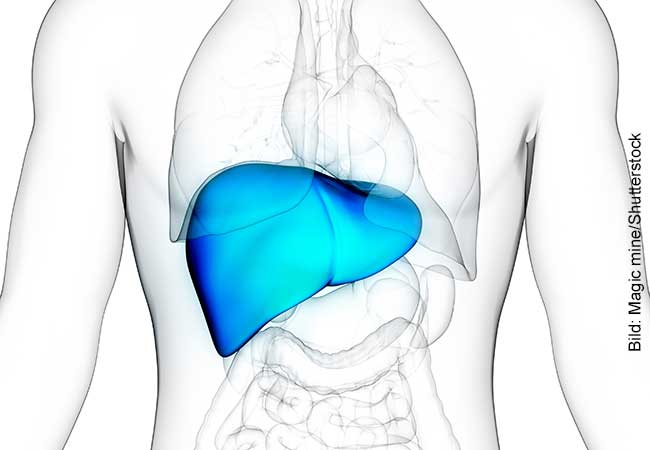In Germany, liver cirrhosis has the highest mortality rate of any chronic disease requiring hospital admission. When diagnosed as a comorbidity of other chronic diseases, liver cirrhosis at least doubles the mortality rate. Overall, the number of patients hospitalised with liver cirrhosis has increased throughout Germany despite the introduction of very effective drugs for treating hepatitis, and alcohol abuse remains by far the most common cause. These are the results of a study headed by Prof. Jonel Trebicka at the University Hospital Frankfurt, which observed patients over a period of 14 years.
Cirrhosis, a disease of the liver in which tissue becomes dysfunctional and scarred, is the final stage of most chronic liver diseases and the fourth most frequent cause of death in central Europe. However, until now hardly any current findings have been available on its epidemiological profile in Germany. For this reason, Prof. Jonel Trebicka and his team of researchers investigated the data sets from the German Federal Statistical Office on the approx. 250 million hospital admissions taking place from 2005 to 2018 in Germany for any reason, and categorised them according to the Tenth Revision of the International Classification of Diseases (ICD-10). They found that 0.94 per cent of these hospitalised patients had been diagnosed with cirrhosis of the liver, which in the majority of cases occurred as a comorbidity and not the primary disease. In absolute figures, admissions of patients with liver cirrhosis rose from 151,108 to 181,688 during the observation period.
The primary end point of the study was the mortality rate from liver cirrhosis in hospital. This did indeed exhibit a welcome fall from 11.57% to 9.49% during the investigation period, but it is still much higher than the respective rates for other chronic diseases such as cardiac insufficiency (8.4%), renal failure (6.4%) and chronic obstructive pulmonary disease (5.2%). In cases where liver cirrhosis was comorbid with another chronic disease, it increased that disease’s mortality rate two to three fold; the greatest effect was observed with infectious respiratory diseases.
Thanks to the introduction of direct-acting antivirals to combat Hepatitis C, the proportion of HCV-related cirrhosis fell during the observation period to around one third. On the other hand, the frequency of cirrhosis caused by non-alcoholic fatty liver disease quadrupled during the same period, in parallel with a rise in the number of obese patients. However, despite these etiological trends, cirrhosis caused by alcohol abuse continues to dominate. It accounts for 52 per cent of all cirrhoses in the study, and the absolute number is still rising.
Gastrointestinal bleeding is becoming increasingly rare as a complication of liver cirrhosis in hospital patients, presumably due to the treatment guidelines that continue to be applied in German hospitals, including endoscopic procedures or the administration of non-selective beta blockers. By 2018, bleeding from oesophageal varices had shrunk to one tenth of its original level in 2005. On the other hand, deterioration of symptoms owing to ascites or hepatic encephalopathy caused by insufficient detoxification by the liver has increased. The number of portal vein thromboses doubled in parallel with the intensified use of imaging diagnostics.
The patients admitted with cirrhosis were much younger than those with other chronic diseases: half of them were under the age of 64. Higher hospitalisation rates and in-hospital mortality rates were recorded in the eastern German states than in western Germany. Across the country, around two thirds of patients hospitalised with liver cirrhosis were men. Many of them died while in their fifties or younger, which explains the large number of disability-adjusted life years and the enormous socio-economic burden caused by liver cirrhosis, as men in this age group still account for the majority of the labour force.
“The results of our study show that the decision-makers and financing bodies in the health system should invest much more in the prevention of alcohol-related liver cirrhosis,” Prof. Jonel Trebicka concludes. “They also point up how important it is to recognise and treat liver cirrhosis as a comorbidity of other chronic diseases.”
Publication: Wenyi Gu, Hannah Hortlik, Hans-Peter Erasmus, Louisa Schaaf, Yasmin Zeleke, Frank E. Uschner, Philip Ferstl, Martin Schulz, Kai-Henrik Peiffer, Alexander Queck, Tilman Sauerbruch, Maximilian Joseph Brol, Gernot Rohde, Cristina Sanchez, Richard Moreau, Vicente Arroyo, Stefan Zeuzem, Christoph Welsch, Jonel Trebicka: Trends and the course of liver cirrhosis and its complications in Germany: Nationwide population-based study (2005 to 2018) The Lancet Regional Health – Europe 2022;12: 100240 https://doi.org/10.1016/j.lanepe.2021.100240










